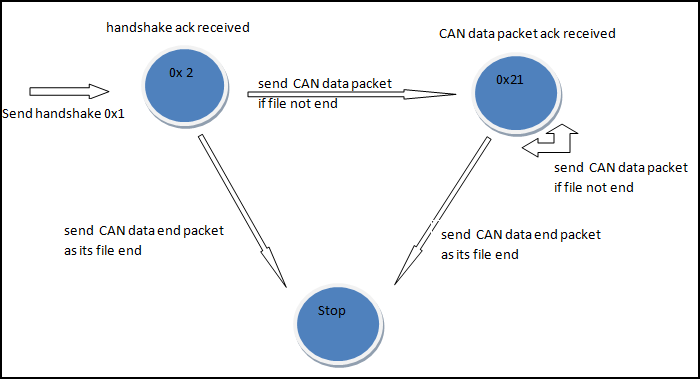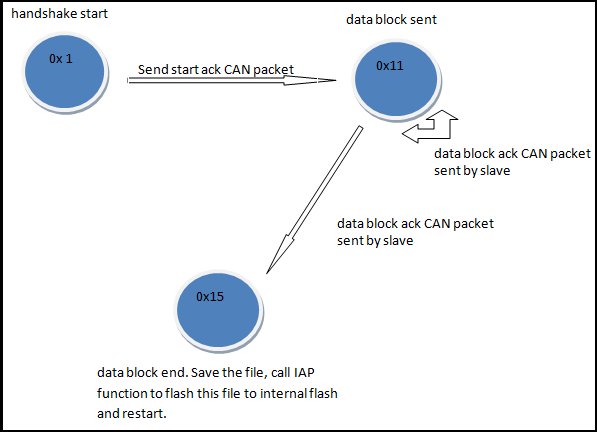Difference between revisions of "S14: CAN Firmware Uploader"
Proj user3 (talk | contribs) (→Hardware Design) |
Proj user3 (talk | contribs) (→Hardware Design) |
||
| Line 159: | Line 159: | ||
The SJSU CMPE Board is powered over this connector. The 5V obtained from VBUS pin of this connector is used to power the MCP2551 IC on the CAN Transceiver board. | The SJSU CMPE Board is powered over this connector. The 5V obtained from VBUS pin of this connector is used to power the MCP2551 IC on the CAN Transceiver board. | ||
| + | |||
| + | [[File:Example.jpg]] | ||
=== Hardware Interface === | === Hardware Interface === | ||
Revision as of 08:57, 22 May 2014
Contents
Grading Criteria
- How well is Software & Hardware Design described?
- How well can this report be used to reproduce this project?
- Code Quality
- Overall Report Quality:
- Software Block Diagrams
- Hardware Block Diagrams
- Schematic Quality
- Quality of technical challenges and solutions adopted.
Project Title
CAN Firmware Uploader
Abstract
Designing a method to load firmware through CAN bus. Master device will be able to load firmware in a slave device.
Objectives & Introduction
The main objective of this project is to design a CAN boot loader protocol. The firmware will be stored in .bin format in the SD card and this card will be connected to master device. This bin file will be transferred from master device to slave device through CAN bus. The receiver board flashes this received bin file into internal flash from external flash using IAP once this file transfer process is completed and restarts to start executing from this newly flashed bin file.
Team Members & Responsibilities
- Pradyumna Upadhya
- CAN Bus Driver Software Design
- In Application Programming
- Yash Parulekar
- Hardware Design
- SPI Flash Driver Software Design
Schedule
| Sl. No | Start Date | End Date | Task | Actual | |
|---|---|---|---|---|---|
| 1 | 2/25 | 2/28 | Order CAN Transceiver | Completed | |
| 2 | 3/1 | 3/7 | Procure Components | Completed | |
| 3 | 3/8 | 3/14 | Build H/w and read on establishing CAN communication | Completed.Hardware built. Plan to test it with CAN driver by 3/22 | |
| 4 | 3/15 | 3/21 | Design CAN protocol and Establish SIMPLE CAN communication | Completed on 4/17. We faced few problems in CAN driver and hardware. | |
| 5 | 3/22 | 3/28 | Read/Develop about SPI Flash driver to read and write .bin files | Completed on 4/21. Integrating bin reading logic with CAN driver. | |
| 6 | 3/29 | 4/11 | Transmit .bin file by integrating SPI driver and CAN | Ongoing. Tried sending sample bin to the receiver board. File save logic at receiver is being implemented now. As of now facing few sync problems in CAN ISR. Completed on 5/1/2014. | |
| 7 | 4/12 | 4/18 | Read about IAP | Completed on 4/22 | |
| 8 | 4/19 | 4/25 | Implement IAP | Completed on 4/22. It has to be integrated with CAN transfer state diagram logic. | |
| 9 | 4/26 | 5/5 | Testing and remove bugs, further enhancements | Ongoing. Completed testing on 5/1/2014. Further enhancements could not be done due to time constraints. | |
| 10 | 5/8 | 5/8 | Demo | Demo is on 5/22/2014. Wiki page update going on. Demo will be given at 5/22/2014 6pm and Wiki page updation will be completed by 6pm. |
Parts List & Cost
| Parts | Cost* |
|---|---|
|
SJ One Board[1] |
$80.00 x2 |
|
MCP2551 |
$1.02 x2 |
|
Twisted Pair Cable |
Junk |
Design & Implementation
The design section can go over your hardware and software design. Organize this section using sub-sections that go over your design and implementation.
Hardware Design
Hardware features of SJSU One board used:
1. External Atmel DataFlash AT45DB08
This is used on all slave controllers. This is as a temporary storage for the CAN firmware (.bin file)received by the slave over CAN bus.
2. Micro SD Card interface
This is used on the master controller. The master reads the CAN firmware (.bin) files from the SD card.
3. LPC1758 (CAN module and SSP module)
This is the microcontroller for the system
4. Mini-USB Connector
VBUS pin of this connector is used to power the MCP2551 IC on the CAN Transceiver board.
The SJSU CMPE Board is powered over this connector. The 5V obtained from VBUS pin of this connector is used to power the MCP2551 IC on the CAN Transceiver board.
Hardware Interface
In this section, you can describe how your hardware communicates, such as which BUSes used. You can discuss your driver implementation here, such that the Software Design section is isolated to talk about high level workings rather than inner working of your project.
Software Design and Implementation
In this project a bin file is transferred from Master SJSUOne board to Slave SJSUOne board via CAN. Both of these boards are connected to CAN transceivers as explained in hardware section and these transceivers are connected to each other through can bus. For the software implementation of this project we are using concepts like -
1. CAN driver
2. IAP
3. File access API
1. CAN driver -
Controller Area Network is a very deterministic communication bus which is heavily used in automotive industry. It is a differential pair half duplex bus. 100K, 250K, 500K or 1Mbit speed are the standards. We are using 100Kbit speed in out project. Each frame of CAN data contains 0 to 8 bytes of data in it and has 11bit or 29bit message ID. We are using 1 or 8 bytes of data in CAN frames and are also using 11 bit messageID.
First step in software part implementation of this project is development of CAN driver. We have reused the CAN driver present in the software project present inside the setup provided by Prof. Preet in http://www.socialledge.com. CAN drivers are implemented in can.c and can.h. These files are uploaded as a part of Master project and Slave project. Steps to implement can driver -
i. Use the files named can.c and can.h given by Prof. Preet. These files has the basic CAN driver functionality.
ii. Check whether transceivers are working by using self- loop test at both the master and slave end separately. If self test-loop is working then it means that transceiver connection with the board is working. There is a function named 'bool CAN_test2(void )' in can.c file (in the Master project)and this function can be used to test self-test loop functionality.
2. IAP-
A boot loader's main functionality is to copy a bin file from external memory like external flash to internal flash when the program is executing. When we load a program from Hyperload to SJSUOne board through USB wire IAP is used to flash the bin file from PC to internal flash. We are using this same functionality to flash bin file from external flash to internal flash. The only difference is that when hyperload is used USB/UART is used to transfer the data while in our project we are using CAN to transfer bin file. Steps to use IAP - i. Use Flash Magic to flash IAP project into SJSUOne board. Project named 'lpc1758_Hyperload_uart_sdcard_spiflash' which is provided in the setup files of SJSUOne board has the IAP functionality. This file has to be flashed into SJSUOne board's internal flash and after flashing this file occupies first 64k byte of memory. ii. Any running program can start IAP functionality by calling 'chip_program_from_filename((const char*)&pFilename);' . Here, pFilename is the file path of the bin file which has to flashed into the internal flash. After this function call 'sys_reboot()' has to be called to restart the system. When this restart is done the newly flashed project starts executing.
3. File access API-
SJSUOne board has Micro SD card slot and LPC1758 processor has external flash of size 1mb. File I/O tutotial in 'http://www.socialledge.com/' can be read to get an idea how to use file system APIs. 'ff.c' file provides the functions to read and write files into micro-sd card or external flash.
Master State Diagram -
Slave State Diagram -
MOM
MOM1 Date: 3/14 1) Read about CAN code by 3/15 2) Get resistors and assemble CAN setup by 3/15 3) Test and modify existing CAN driver by 3/21
Testing & Technical Challenges
Hardware Issues
- Can transceiver needs 5V source and it was difficult to source it. Since we are lazy we sourced this 5V from SJSUOne board's USB connector.
- The wiring used in hardware part of the project used to come off easily and we used proper connectors to avoid this. We also used hot glue to make this wiring stable.
Software Issues
- CAN driver was not working initially. Few small changes were required in it. Can files in uploaded projects works properly and can be used for any can projects.
- Initially the idea was to send 512 bytes at a time from master to slave and then slave sends acknowledgement byte. But this was resulting in buffer overflow error at the receiver end because the speed at which receiver used to take data from hardware register was slow compared to the speed at which master used to send the data. To avoid this problem acknowledgment data was sent from slave to master every time when it received data packet. This helped in adding synchronization to the communication protocol.
- Initially hex file was sent from master to slave and it was tried to flash. But we realized later on that bin file has to be sent and hex or elf shouldn't sent as these formats add extra data in the file.
Conclusion
This project was a good learning experience for us. We got an idea about CAN driver. We understood the basic functionality of a boot loader and how it actually works. We understood the flow of project flashing through hyper load and CAN and this understanding of IAP helped us understand the flow of project compilation to project execution.
Project Video
Upload a video of your project and post the link here.
Project Source Code
Send me your zipped source code and I will upload this to SourceForge and link it for you.
References
Acknowledgement
Any acknowledgement that you may wish to provide can be included here.
References Used
List any references used in project.
Appendix
You can list the references you used.


